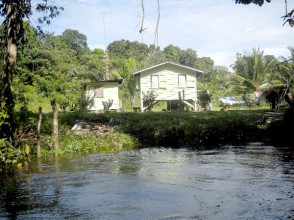My guides were reluctant to enter the mouth of the creek, even if they would not say it outright. “You could go but we got to get permission,” one says. They had wanted to turn back obviously having little regard for the story I needed to tell. I told them to press on and we did, under an arching canopy of trees lining the dark waters of the Bethany Creek.
Seen one, seen all. That was my initial thought upon learning that I was headed Bethany way, up the Supenaam River. I could already hear the clichéd descriptions of all hinterland villages: peaceful, quiet friendly, easy-going and so on.
Bethany sounds biblical and in fact, the name is mentioned in the Bible several times. “We have our own philosophy. We believe God should come first, in our entire life,” David Paton, an elder in the community’s Seventh Day Adventist (SDA) church speaks to me from his boat. Like many other hinterland communities, life in Bethany is intimately entwined with the church; it is just the denominations that change sometimes.
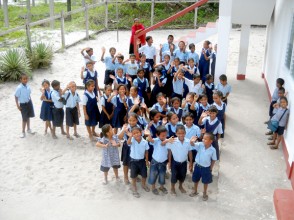
Bethany’s lone church is the SDA, started about 100 years ago by missionaries. The wooden building sits on the crest of a white sandy hill close to the concrete primary school – the old and the new together in a sleepy rainforest community. Paton reels off the stats: Population-350 consisting of Arawaks with a sprinkling of Caribs; Main industries: logging and farming; Religion: predominantly Seventh Day Adventist.
Religion shaped and continues to shape Bethany. “We are a simple people but there is an abundance of knowledge and we owe it all to God,” Paton says. Most of the villagers are fairly literate, he said. Americans came, established a college and an airstrip offering courses in theology and “natural remedies” and free flights to the city hospital for the ill.
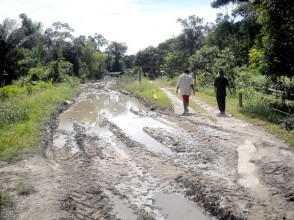
Bethany has come a long way. “I’m near like a pastor although I didn’t do a degree course in theology,” Paton says. “We learn, we don’t depend on white people to come and help us.” Children have a chance of getting a higher education and residents have become nurses, teachers, health workers and so on. “We’re going up,” Paton says.
Old ways are old ways. The Arawak language is “just a sprinkling of words” among the elderly. “I haven’t been spoken to in any dialect save English,” Paton, 59, confesses. He adds that he is willing to learn if someone can teach him. People in the community won’t eat pork or labba “or those sort of thing” and eat less meat than before. “The meat consumption might be less because we realize there are dangers to too much meat eating,” Paton says.
V alues are changing.
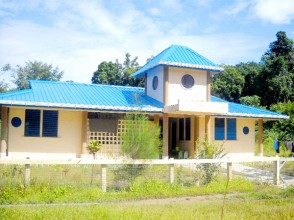
People don’t know the Bible as before, but sometimes turn back to the church when they have problems, Paton said. “In our day we couldn’t talk about sex in the church but now you can. It’s more open. People can express themselves more regularly.”
People came to Bethany and stayed and vice versa. Linda Russell, another elder in the church explains that residents leave to seek jobs. The economic mainstay, logging, is declining and some are turning to farming but others, particularly youths, leave. “When they come back, they are changed, they are not the same,” Russell said. She had arrived as a tot when her parents left Bartica to seek jobs in Bethany. “This is home. I grew up here,” she said. “Now things really changing.”
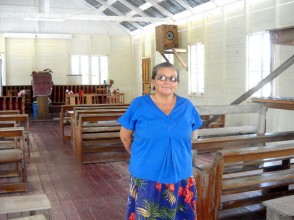
There have been a few petty crimes though apart from the case of Ronald Daniels, who is currently awaiting trial in the high court for allegedly committing murder, not big enough to cause major ripples.
Two trails, side by side, lead to the mission. One deeply rutted and muddy and the other, white sand, well maintained with arches to prevent vehicles from using it. An occasional paddle boat eases up to the landing at Bethany Creek, where parked tractors await their operators to return to the forest for more logs. In the nights, persons use generators and lamps for lights and GTT’s cellular service reaches the community.
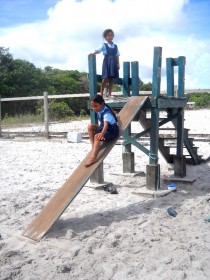
Bethany could well be the model village: fairly new school powered with solar energy; new health centre and cooling shade from trees and splashing dark creeks to soothe the mind, body and soul. A peaceful, serene place, slumbering along, nary a care in the world.
Except that the solar panel has not worked for two years and don’t get sick because the $14M health centre remains locked. The health worker left about six months ago for a three-year training period and no replacement was provided except a once monthly visit by a medex that villagers say is not enough. When someone falls ill, they cannot get any medicine, one upset resident said. He said that this is “an issue that comes up every week when a sick person comes in. Sometimes I sit here feeling sorry for the people coming here and waiting,” he observed.
The solar panel gleams on the school’s roof, but about two years ago, the inverter was damaged and villagers cannot fix it. Regional authorities had promised to send someone to repair it but never came, teachers said. So now the teachers buy batteries to power the CD players for the children’s literacy and maths programmes. The little playground is also in need of an upgrade with children using a board for a slide.
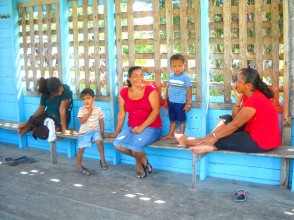
The village has a boat while a private operator also offers hires. But teachers said that many children paddle to school and for those coming from the Supenaam Creek during the high tide and rainy season, it is rough for the kids and some don’t make it during these times. Additionally, residents expressed concern that the elderly have to paddle to Supenaam to collect their little pension and this can take hours for those folks.
Behind every house, every face, everything, there is a story. Like the half-built house slowly being taken over by undergrowth – left that way because of the broken heart of a man whose wife left him; or the two side-by-side trails – one deeply rutted and muddy and the other a carpet of white sand, built on the initiative of a volunteer in Bethany. A pair of purple ‘crocs’ well hidden and placed neatly under a white, wooden bridge say that children are hidden somewhere. Women wait in a shed at the riverside where tractors idle.
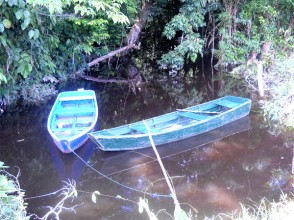
M y guides faced a dilemma that showed more in their expression than words. Like all Amerindian villages, “outsiders” need permission from the village captain or council to enter and the captain wasn’t in. We arrived and they decided it would be safer if a villager accompanied us to the mission itself. It is a quiet walk on the carpet of white sand flanked by the overhanging trees of the forest that breathes a cool breeze on those walking under its shadow.
